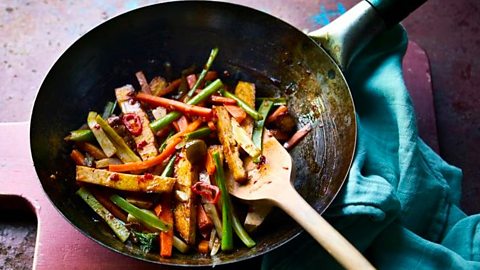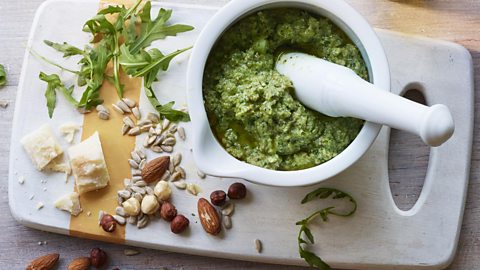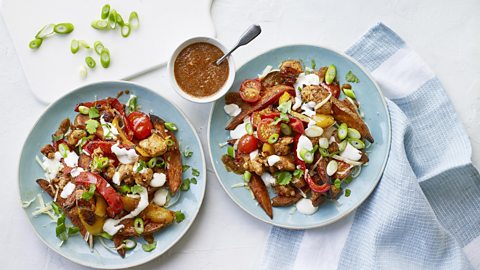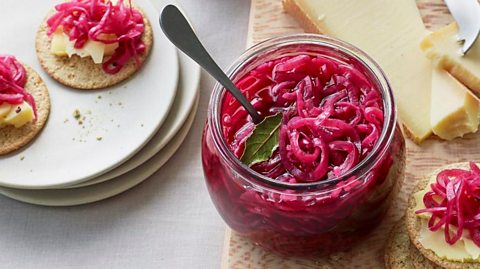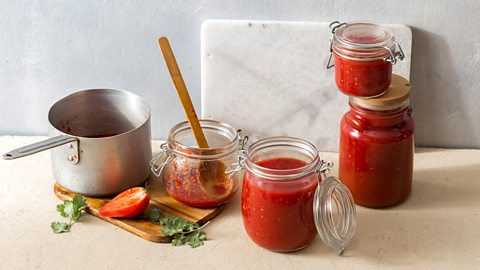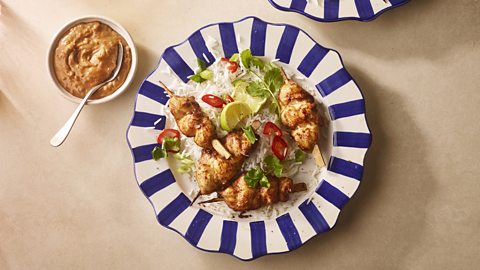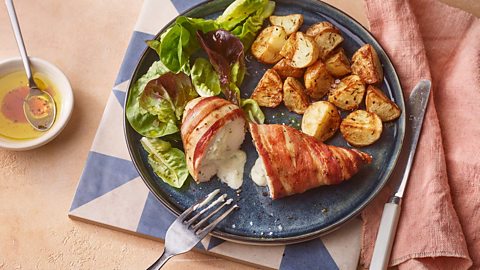Chefs reveal their secrets for using up leftovers
Chefs have ingenious ways to reduce food waste at home and in restaurants, using leftover veg and aromatics to make delicious pickles and pastes for the cupboard or preserving them for another day using new and old techniques. Here they share them with us.
Freeze aromatics in ice-cube trays
If aromatics start to lose their fragrance, blend “ginger, garlic, lemongrass, galangal, lime leaves or different coloured chillies [separately] and freeze them in ice-cube trays or flattened freezer bags so you can break them up into rough ‘tablespoons’”, says Ready Steady Cook chef Jeremy Pang. “You’ll have a pick-and-mix of curry paste [ingredients] for curries, stir-fries or marinades”. Label the paste bags so you know what you’re getting, and use in recipes such as Pang’s leftover vegetable stir-fry.
Cook Shivi Ramoutar chops or slices herbs, berries and citrus fruits, and pops them into ice-cube trays to freeze. You can use them in glasses of water or cocktails.
Make stock and soup from leftover veg
“Save all your root veg peelings – carrots, potatoes, parsnips – and even broccoli and cauliflower stalks, pop into a bag and freeze” to turn into stock, says Nadiya Hussain. With the addition of a few basic ingredient, stock can be quickly be transformed into soups, curries, risottos, and stews. Watch the video below to see how to make a simple ramen from stock.
Make dips and snacks from salad and veg leaves
Leaves and herbs often end up in the bin, but chefs have lots of tricks for preserving them.
With vegetable leaves or stems, “most are delicious if you chop them up and cook them slowly with chilli, garlic and butter”, says Rose Ashby, head chef at Spring in London. (Some leaves are inedible, such as rhubarb, so check before you eat.)“If you’re roasting cauliflower, try adding the leaves to a mixing bowl, drizzle with a splash of oil and season with salt and pepper”, suggest Roxy and Ben, aka ‘So Vegan’, then roast them for 8-12 minutes. Cauliflower leaves can be eaten raw, or fried, boiled or roasted and added to a stir-fry, curry or stew.
Pesto is just as good made from leftover salad leaves or gluts of leaves. “Wild garlic season seems too fleeting every year, so I make a pesto from it that I can still use later in the year”, says Michelin-starred chef Merlin Labron-Johnson of Osip in Bruton, Somerset.
Chef Max La Mana, author of More Plants Less Waste, makes a flavour-bomb paste for soups, stir-fries and stews using leftover leaves. “Add them to a large bowl [and] cover with boiling water for 30 seconds. Once bright green, strain them and cover them with cold water from the tap for 1-2 minutes. Remove from the water, place them in a blender or food processor, add a few garlic cloves and/or ginger and blend to a smooth, green purée. You may need to add a bit of water to keep it smooth.” Pour the purée into ice-cube trays and freeze it to flavour your dishes.
Add leftover veg to your planned meals
Cook flexibly, advises Ready Steady Cook chef Akis Petretzikis. “Do you have leftover cooked chicken? Finely chop it and put it on a pizza. Do you have leftover or over-ripe vegetables? Make a delicious vegetable lasagne”, he says. There are many dishes to which you can add almost anything you have leftover, such as a soup, a stew and a pie.
But “the most effective way to reduce food waste is to simply buy less and plan more”, says Will Devlin, chef-patron at The Small Holding in Kilndown, Kent. If you plan your meals and know how much of each ingredient you need each week, you can reduce the chance of it being forgotten about. For example, “buying a few single carrots rather than a 2kg plastic bag of them will save money, plus reduce food and plastic waste”, he says.
Make the most of fruit and veg peelings
“Leave the skin on sweet potatoes”, says Ready Steady Cook chef Romy Gill, for example in sweet potato wedges – just be sure to wash them first. The same principle goes for regular potatoes, carrots, parsnips and even thin-skinned squashes. Any peelings you do have can be turned into crisps by roasting them.
Don’t forget fruit peelings and trimmings too. Labron-Johnson puts “apple or pear… peel and cores into a basic wine or cider vinegar… I use them for glazes or sauces that I serve with meat”.
Rustle up a pickle
Pickles are perfect for using up a glut. Romy Gill makes a delicious beetroot pickle. Also try cucumber pickle, pickled red cabbage, or red onion pickle. A great place to start is with a quick pickle, which you can make with many different vegetables.
You can also ferment “a kimchi-inspired preserve”, says Chantelle Nicholson, chef-patron at Tredwells in London. Blend ginger, garlic, salt and a little vinegar with some gochugaru (a Korean chilli powder, but you can use a substitute). Shred vegetables, such as celeriac, carrots, cabbage and fennel, massage the paste into the veg and pack into a sterilised sealable jar. “Leave to ferment for 4-6 days [in a cool, dark place], then pop in the fridge”, says Nicholson. Unseal and release the gas from the jar if you see bubbles forming. You can also ferment cabbage to make sauerkraut
Jam is perfect for using up strawberries, plums, blackberries, cherries and other fruits.
Compost your produce
You can start “a compost pile at the back of your garden” for veg scraps, says cook Gaz Oakley. “In a few months you will have nutrient-rich compost you can grow food in… this natural cycle is cost-saving, healthier for the environment, and turns food waste into something beneficial.”
